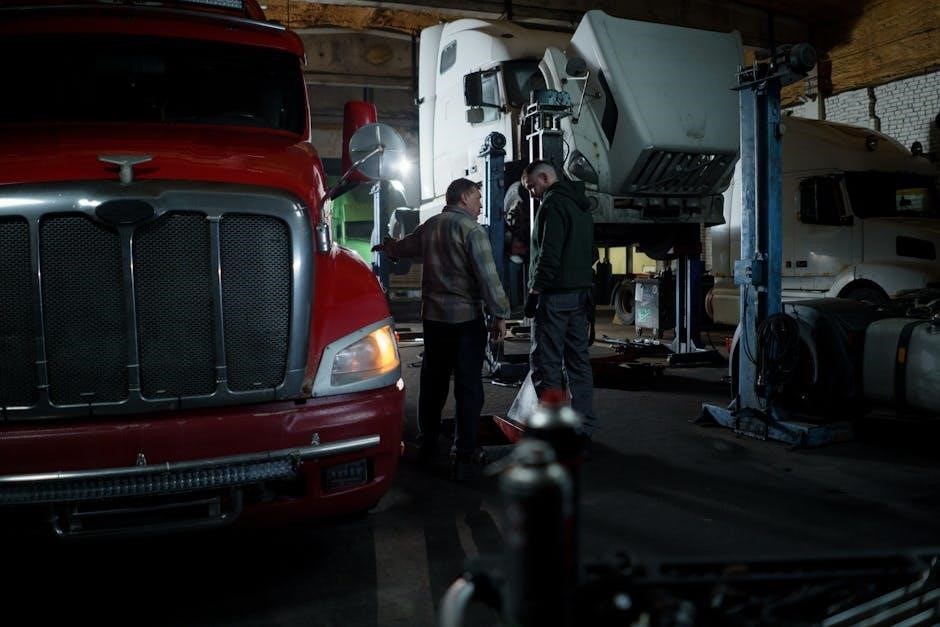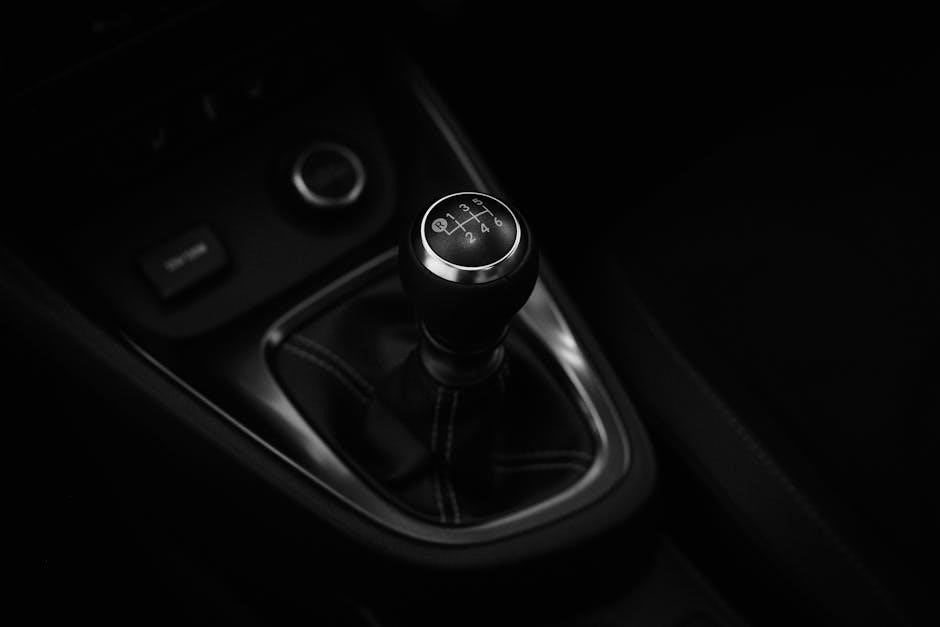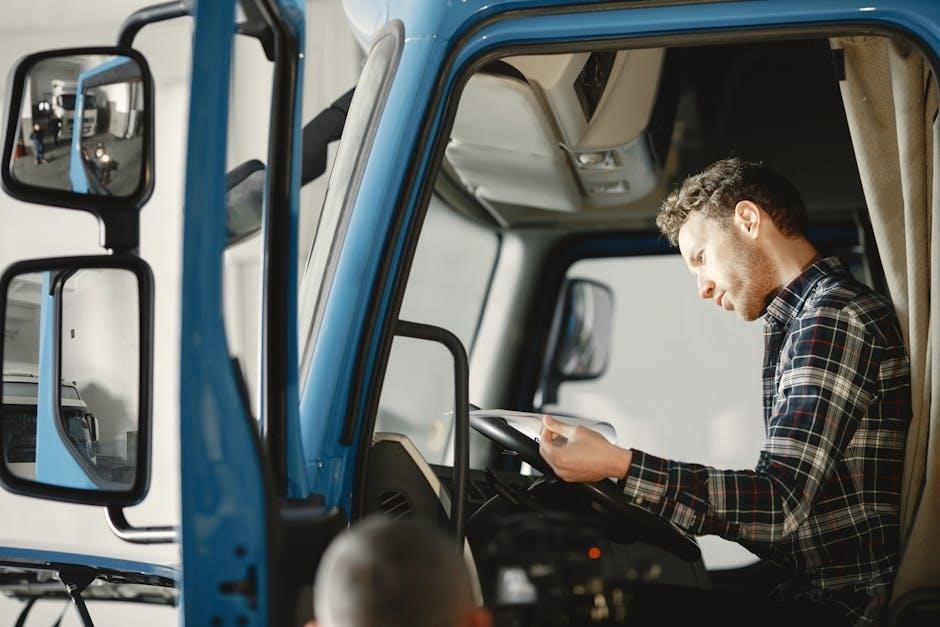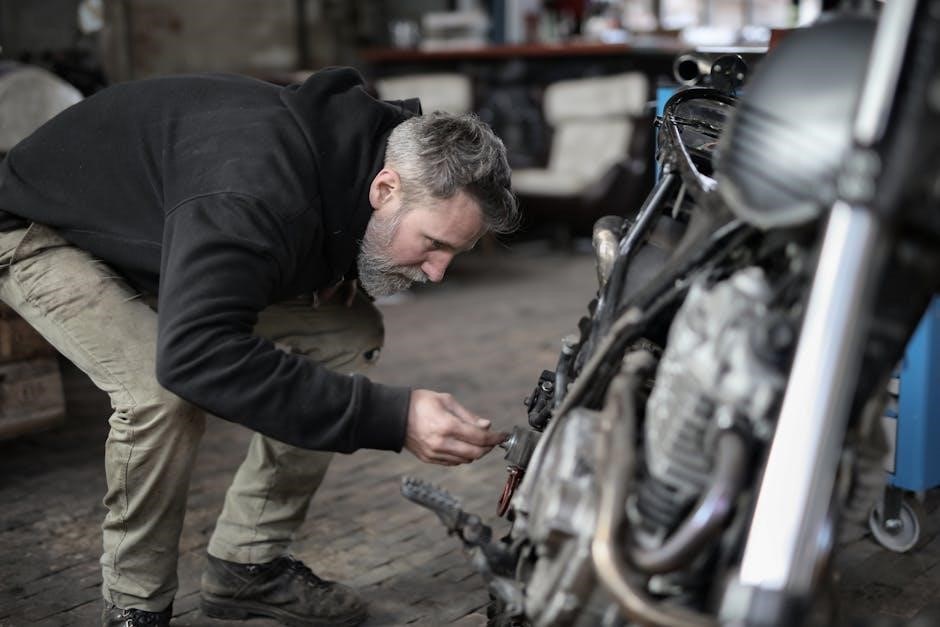Converting a manual to automatic transmission is a significant process‚ often pursued for ease of use or medical reasons. This guide explores factors‚ costs‚ and steps involved.
1.1 Overview of Transmission Types
Manual transmissions rely on driver input to shift gears‚ offering control and fuel efficiency. Automatic transmissions use a torque converter or similar mechanism for seamless gear shifts without manual intervention. Semi-automatic and dual-clutch transmissions blend elements of both‚ providing automatic shifting with manual mode options. Each type suits different driving styles and preferences‚ influencing the decision to convert from manual to automatic.
Understanding these differences is crucial for evaluating the feasibility of a manual-to-automatic conversion‚ as it impacts both the process and the outcome. The choice between simplicity‚ control‚ and convenience drives transmission preferences‚ making conversion a viable option for specific needs and lifestyles.
1.2 Brief History of Transmission Development
Manual transmissions dominated early automotive history due to simplicity and fuel efficiency. The first automatic transmission emerged in the 1940s‚ offering convenience. By the 1980s‚ automatics became widespread in the U.S.‚ while manuals remained popular elsewhere. Modern advancements have refined both types‚ with automatics now favored for ease of use‚ especially in urban driving conditions.
Understanding the Basics of Manual and Automatic Transmissions
Manual transmissions require driver interaction with a clutch and gearshift‚ offering control. Automatics use a torque converter for seamless gear changes‚ prioritizing convenience over driver involvement.
2.1 How Manual Transmissions Work
A manual transmission relies on a clutch pedal and gearshift to change gears. The driver presses the clutch‚ disconnecting the engine from the transmission‚ and selects the desired gear. Releasing the clutch slowly engages the new gear‚ allowing the vehicle to move smoothly. This process requires driver input and coordination between accelerator and clutch pedals.
The transmission consists of gears‚ shafts‚ and bearings. When the driver shifts‚ the gears mesh to provide the correct speed and torque ratio. Manual transmissions are known for their fuel efficiency‚ control‚ and cost-effectiveness compared to automatics‚ making them popular among driving enthusiasts.
2.2 How Automatic Transmissions Work
Automatic transmissions use a torque converter to transfer engine power to the wheels. They rely on sensors and hydraulic systems to automatically shift gears based on speed and throttle input. The transmission consists of planetary gears‚ clutches‚ and bands‚ which engage and disengage to provide seamless gear transitions without driver intervention. This system offers convenience and ease of use‚ especially in heavy traffic conditions.
The automatic transmission continuously monitors driving conditions and adjusts gears accordingly‚ ensuring optimal performance and fuel efficiency. It eliminates the need for manual clutch operation‚ making it a preferred choice for many drivers seeking comfort and simplicity behind the wheel.

Feasibility of Converting Manual to Automatic
Converting a manual to automatic transmission is feasible but depends on compatibility and parts availability. Success varies by vehicle‚ often requiring significant time and resources.
3.1 Can All Manual Cars Be Converted to Automatic?
Not all manual cars can be converted to automatic due to compatibility and parts availability. Modern vehicles often lack interchangeable components‚ making conversions complex and costly. While older models may offer easier swaps‚ newer cars with specialized transmissions pose significant challenges. Always research specific make and model compatibility before pursuing a conversion.
3.2 Factors to Consider Before Conversion
Before converting‚ assess cost‚ parts compatibility‚ and feasibility. Ensure the vehicle’s make and model support the swap. Consider labor expenses and the availability of transmission components. Reflect on personal needs and whether the conversion aligns with long-term goals. Research local regulations and warranty implications to make an informed decision.

Cost of Manual to Automatic Conversion
Converting a manual to automatic transmission can cost between Rs 80‚000 to 1 lakh‚ often comparable to buying a new automatic vehicle like a Tata Nano.
4.1 Estimated Expenses for Parts and Labor
Estimated expenses for manual to automatic conversion include Rs 50‚000 to 70‚000 for transmission parts and Rs 30‚000 to 40‚000 for labor. Costs vary based on the vehicle model and transmission type‚ with older models generally cheaper. Luxury or modern vehicles may require custom fabrication‚ increasing labor costs. Total expenses often range between Rs 80‚000 to 1 lakh‚ depending on complexity and availability of components.
4.2 Comparison with Buying a New Automatic Vehicle
Converting a manual to automatic often costs between Rs 80‚000 to 1 lakh‚ comparable to buying a budget new automatic vehicle like a Tata Nano. Many experts suggest purchasing a pre-owned or new automatic car is more cost-effective‚ as conversion expenses may not offer long-term savings. This option also avoids potential risks of custom fabrication and ensures warranty coverage on a new vehicle.
Step-by-Step Process of Conversion
Converting a manual to automatic involves sourcing the right transmission‚ adapting mechanical components‚ and ensuring compatibility. After installation‚ thorough testing and fine-tuning are essential for smooth operation.
5.1 Sourcing the Right Transmission and Components
Sourcing the correct transmission and components is crucial for a successful conversion. Ensure the transmission model is compatible with your vehicle’s make‚ model‚ and engine type. Components like the torque converter‚ adapter plate‚ and wiring harness must be sourced from reputable suppliers or salvage yards. Online forums and specialty shops often provide valuable guidance and parts for specific vehicle conversions. Always verify compatibility and seek professional advice to avoid costly mismatches.
5.2 Mechanical Adjustments and Modifications
Converting to automatic requires significant mechanical adjustments‚ including transmission installation‚ torque converter setup‚ and wiring harness modifications. The clutch pedal must be removed or disabled‚ and the brake system may need upgrades. Mounts‚ crossmembers‚ and driveshaft adjustments are often necessary. Precision is key to ensure compatibility and functionality. Professional expertise is highly recommended to avoid costly errors and ensure reliability.
5.4 Testing and Fine-Tuning the System
After conversion‚ thorough testing is essential to ensure smooth operation. This includes road tests to check shifting‚ acceleration‚ and braking. Monitor for leaks‚ unusual noises‚ or performance issues. Fine-tuning may involve adjusting Torque Converter engagement or recalibrating the ECU. Proper testing ensures reliability and optimal performance. Consulting a professional is crucial for identifying and resolving any post-conversion issues.
Legal and Safety Considerations
Ensure the conversion complies with local vehicle regulations and safety standards. A professional inspection is essential to avoid legal issues and ensure roadworthiness post-conversion.
6.1 Compliance with Local Vehicle Regulations
Converting a manual to automatic transmission requires adherence to local vehicle regulations. Ensure the modifications meet emissions and safety standards. Obtain necessary certifications and inspections to avoid legal complications. Notify authorities about the change to maintain compliance‚ as failure to do so may result in fines or registration issues. Always verify regional requirements before proceeding.
6.2 Ensuring Safety Post-Conversion
Ensuring safety post-conversion requires meticulous testing of the automatic transmission system. Professional inspection is crucial to identify any malfunctions. All components must be compatible and properly integrated to prevent mechanical failures. Regular checks can help mitigate risks associated with the conversion process‚ ensuring the vehicle operates safely and efficiently on the road for optimal performance and driver confidence always.
Maintenance and Care After Conversion
Regular maintenance is crucial post-conversion to ensure optimal performance. Schedule frequent checks for transmission fluid levels and filter replacements to prevent mechanical issues and extend lifespan.
7.1 Regular Servicing Requirements
Regular servicing post-conversion is essential to maintain performance. This includes checking transmission fluid levels‚ replacing filters‚ and ensuring all components function smoothly. Proper maintenance prevents mechanical failures and extends lifespan. Typically‚ servicing costs range from $500 to $2‚000 annually‚ depending on the vehicle and labor rates. Consistent care ensures optimal performance and reliability.
7.2 Common Issues to Watch Out For
Post-conversion issues may include compatibility problems‚ high costs‚ and labor-intensive adjustments. Transmission swaps can lead to mechanical failures if not done correctly. Additionally‚ sourcing rare parts and ensuring proper installation are common challenges. Regular monitoring of fluid levels and component wear is crucial to prevent long-term damage and maintain optimal performance.

Pros and Cons of Manual to Automatic Conversion
Converting to automatic offers convenience and ease‚ especially for those with mobility issues. However‚ high costs‚ complexity‚ and limited part availability can make it less practical for some owners.
8.1 Advantages of Automatic Transmission
Automatic transmissions offer enhanced convenience‚ especially in heavy traffic‚ eliminating the need for constant clutch and gear shifts. They provide smoother acceleration and reduced driver fatigue‚ making long trips more comfortable. Additionally‚ automatics are ideal for drivers with physical challenges‚ such as inability to operate a clutch pedal‚ and they often improve safety in hilly or congested areas by reducing stalling risks.
8.2 Drawbacks of the Conversion Process
The conversion process is costly‚ with expenses often rivaling the price of a new automatic vehicle. It requires specialized tools and expertise‚ making DIY attempts challenging. Limited availability of compatible parts‚ especially for modern models‚ can complicate the process. Additionally‚ the conversion may not always be cost-effective‚ and some drivers find it more practical to purchase a pre-owned automatic car instead.

Case Studies and Real-World Examples
Real-world examples include successful conversions like the MGB GT‚ where medical needs drove the switch‚ and the Mitsubishi Lancer Ralliart‚ highlighting both achievements and challenges.
9.1 Successful Conversion Stories
A Mitsubishi Lancer Ralliart owner successfully converted their manual transmission to automatic‚ overcoming part-sourcing challenges. Similarly‚ an MGB GT owner switched to automatic due to medical reasons‚ improving comfort and accessibility. These cases highlight the feasibility and benefits of conversion when executed with proper planning and expertise‚ offering inspiration for others considering the process.
9.2 Lessons Learned from Failed Attempts
Some manual-to-automatic conversions have failed due to incompatible transmissions‚ high costs‚ and mechanical complexities. Reddit threads highlight cases where enthusiasts faced unexpected expenses and part shortages. Quora users warn that modern vehicles often lack interchangeable components‚ making conversions impractical. These failed attempts underscore the importance of thorough research and professional expertise before embarking on such projects.
Alternatives to Manual to Automatic Conversion
Buying a pre-owned automatic vehicle or exploring semi-automatic options can be cost-effective alternatives to conversion‚ avoiding the complexity and expense of transmission swaps.
10.1 Buying a Pre-Owned Automatic Vehicle
Purchasing a pre-owned automatic vehicle is a cost-effective alternative to conversion‚ often cheaper than swapping transmissions. It avoids modification risks and provides immediate access to automatic features. Many modern automatic vehicles are available in the used market‚ offering reliability and comfort without the hassle of conversion. This option is especially practical for those seeking a quick‚ stress-free solution.
10.2 Exploring Semi-Automatic or Dual-Clutch Options
Semi-automatic and dual-clutch transmissions offer a middle ground‚ combining manual control with automatic convenience. These systems use electronic actuators for clutch operation‚ reducing pedal wear. They provide smoother acceleration and better fuel efficiency in city driving. For drivers seeking a balance between control and ease‚ these options are a practical alternative to full automatic conversion‚ offering both convenience and engagement.
Converting manual to automatic involves complexity‚ high costs‚ and labor. Weighing alternatives like buying a new automatic car is often more practical‚ especially for long-term savings and convenience.
11.1 Is Manual to Automatic Conversion Worth It?
Converting a manual to automatic transmission is a costly and labor-intensive process. While it offers convenience‚ the high expenses often outweigh benefits unless sentimental value or specific needs justify it. Generally‚ buying a new automatic vehicle is more practical and financially sensible‚ making conversion worthwhile only in rare cases.
11.2 Future Trends in Transmission Technology
Advancements in transmission technology are shifting toward more efficient and automated systems. Automatic transmissions are becoming smoother and more fuel-efficient‚ while CVTs and dual-clutch systems gain popularity. The rise of hybrid and electric vehicles is also influencing transmission development‚ with many manufacturers focusing on seamless integration of powertrains. These innovations aim to enhance performance and driver experience‚ making manual transmissions less common in the future.